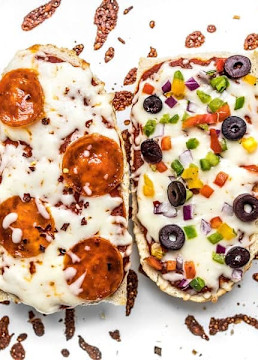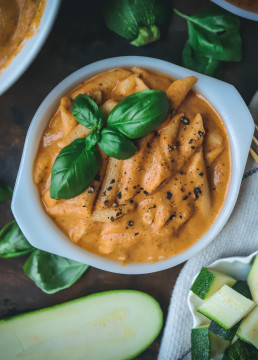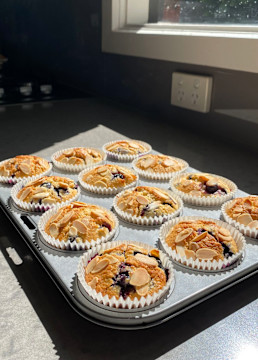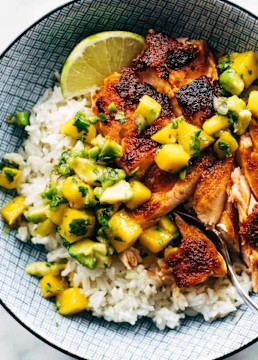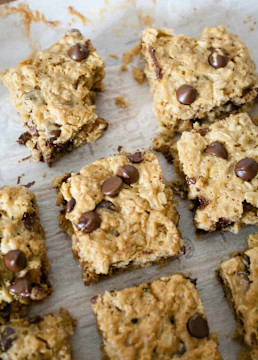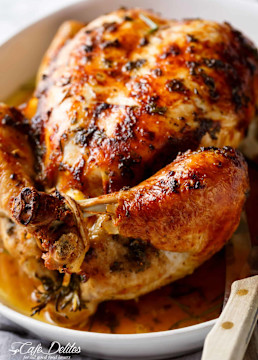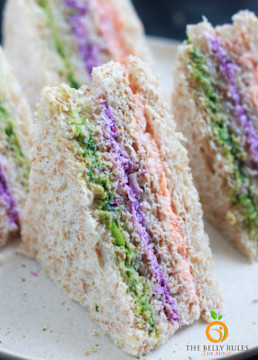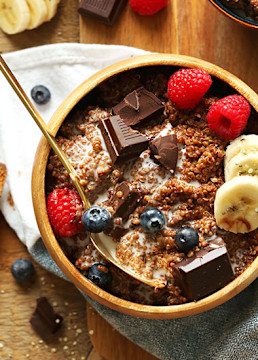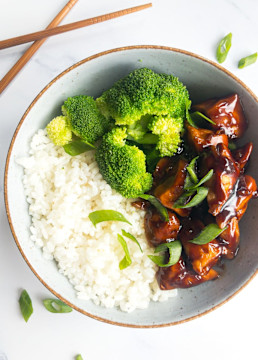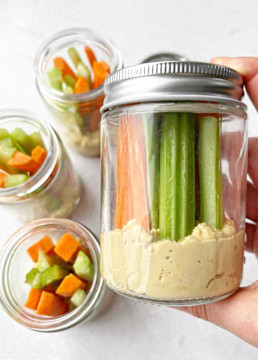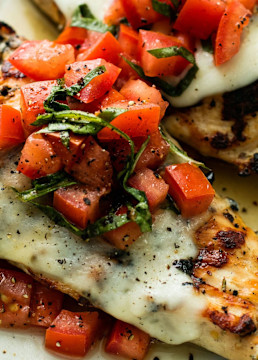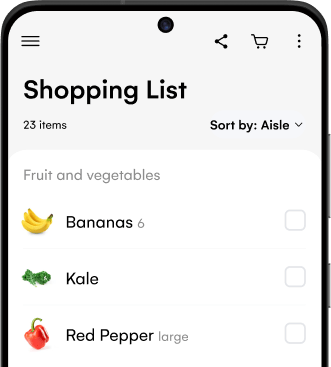Many athletes out there know that carb cycling meal planning requires a lot of hard work. You constantly need to monitor your carb intake…
We’ve simplified the meal planning process with our 7-day meal plan. It takes into account how tiring intense training and workout days can be. So, you’ll see some meal prep days in the mix to save you time, energy, and money. Our meal plan doesn’t compromise on flavor or nutrition either!
Want to make sure this meal plan is right for you? Read more about carb cycling first.
Our 7-day Carb Cycling 2000-Calorie Meal Plan
Day 1 is high carb day for intense trainings or workouts.
For breakfast, you can add a 150 g-low fat yogurt. It can even be a flavored yogurt! You can make it your AM snack if you don’t feel like eating it for breakfast. Always remember to listen to your body.
On Day 1, prepare two servings of each meal. Then store your second servings in an airtight container and place them in your refrigerator.
Day 2 is high carb day for intense trainings or work outs.
For breakfast, pair your yogurt custard toast with 1 glass of apple juice.
For lunch and snacks, remember to prepare two servings for each. You’ll eat the same meals on Day 4!
Day 3 is low carb day for light physical activities and rest days.
For breakfast, add 1 serving of trail mix (28 g) to partner it with the breakfast bars. If you don’t feel like eating it for breakfast, you can have it as your morning snack either. Listen to your body!
For lunch, pair the Garlic Herb Butter Roast Chicken with a simple tossed salad.
Make two servings of all your meals today because you’ll have the same set of meals on Day 7.
Day 4 is high carb day for intense trainings or workouts.
You can pair your breakfast with Yogurt Custard Toast from Day 2. If you don’t feel like eating it for breakfast, you can make it your morning snack instead. Listen to your body!
Did you meal prep your lunch and snacks on Day 2? And meal prep your dinner on Day 1? Then you don’t need to make them anymore. Enjoy!
Day 5 is high carb day for intense trainings or workouts.
Breakfast is the same as Day 1. For breakfast, you can add a 150 g-low fat yogurt. It can even be a flavored yogurt! You can make it your AM snack if you don’t feel like eating it for breakfast. Keep listening to your body.
If you could prepare the rest of the meals from Day 1, you’ll only need to make dinner today!
Day 6 is a low carb day for light physical activities and rest days.
Day 7 is low carb day for light physical activities and rest days.
Breakfast is similar to Day 3. Add 1 serving of trail mix (28 g) to partner it with the breakfast bars. If you don’t feel like eating it for breakfast, you can eat it as a morning snack! Always listen to your body.
Lunch is similar to Day 3. Pair the chicken with simple tossed salad.
Reminder: When you’ll alternate between high and low carb days may vary for each person, type of workout, and training schedule. We all have different calorie needs depending on our age, weight, height, sex, physical activities and medical conditions.
Level of physical activity and goals for this diet are very important. Check with your nutritionist, dietitian, trainer, and a healthcare professional to make sure that it’s right for you.
What is Carb Cycling?
Carb cycling is a dietary strategy that highlights the importance of carbohydrates during intense physical activities. The goal is to strategize when to eat carbohydrates to optimize energy levels, fat loss, muscle growth, and athletic performance. Often, people who are doing intense sports like cycling or ultra running will use a carb cycling meal plan to get the best athletic performance possible.
Like you’ll see above, our 7-day meal plan alternates between high-carbohydrates days and low-carbohydrates days.
On high-carb days:
You’ll consume higher amounts of carbohydrates. They’re usually from healthy sources like whole grains, fruits, and vegetables. These days are good for intense workouts or activities. Carbs can help replenish glycogen stores and support performance.
On low-carb days:
You’ll reduce your carbohydrate intake significantly, focusing more on protein and healthy fats for energy. These days are good when you’re resting or doing light exercise. Because your body uses stored fat for energy instead of carbs.
When do we need to follow carb cycling?
Carb cycling is not for everyone but can be beneficial for elite endurance athletes, body builders, and those training for certain sporting competitions or marathons. However, it’s essential to tailor the approach to individual goals, preferences, and metabolic responses.
Reminders before following a Carb cycling meal plan
1. Consult a healthcare professional
As we’ve mentioned earlier, carb cycling is not for everyone. Sometimes people think a carb cycling meal plan is a path weight loss – but it’s not specifically designed for that. If you have a trainer, it’s best to consult with them first and then before making any significant changes to your diet. It’s crucial to consult with a doctor and a registered dietitian. They can help you determine if carb cycling is suitable for your health, especially if you have any medical conditions or dietary restrictions.
If you’re goal is to lose weight, try to read 7 Strategies to Stay Motivated on Your Weight Loss Journey. You might also want to look at our high protein low calorie meal plan and read up about the benefits of high volume low calorie foods.
2. Balance and quality is important
Even on high-carb days, focus on consuming balanced meals with a combination of carbohydrates, protein, and healthy fats. It doesn’t mean you should have a day of eating just potatoes and bread! This balance helps support overall health, provides sustained energy, and promotes muscle recovery.
3. Avoid extremes
One of the cons of carb cycling for some is that it may seem restrictive. Having a specific carbohydrate target per each day heavily affects your food choices and at times. This is why it’s important to avoid extreme approaches to carb cycling or any diet plan. Extreme restrictions or drastic changes can lead to negative physical and psychological effects. Instead, focus on finding a balance between nutrition and food preferences.
4. Remember to stay hydrated
Drink plenty of water throughout the day, especially during high-carb days when you are scheduled for intense physical activities and are consuming more carbohydrates. Hydration is essential for digestion, metabolism, and overall health.
5. Carb cycling is a temporary approach
Remember that carb cycling is not intended to be a long-term diet plan. It’s a tool that can be used temporarily to achieve specific goals. If carb cycling doesn’t serve you after this, transition to a more balanced and sustainable eating pattern. While carb cycling can be a useful for achieving short-term goals, it’s important to approach it with mindfulness, balance, and flexibility.
Ingredient and Shopping Tips for a Carb Cycling Meal Plan
We’re all about saving time, money, and making your eating habits work for you. Here are a few things to consider when shopping for ingredients for your carb cycling meal plan.
- In this meal plan, you’ll notice that there are dishes that need rice, and tortilla or pita wraps. We’d suggest buying whole grain options for all of these food items!
- After buying your ingredients, you can choose to season your salmon, chicken and pork ahead of time. You can store them raw in the fridge, or you can choose to cook them in advance. Cooking in advance will save you time, but remember to store your meat and fish properly. Store them separately in an airtight containers and place them in the fridge.
Some food safety reminders
Here are some food safety tips to keep in mind when you’re meal prepping
- Start with clean hands and surfaces.
- Use separate utensils, cutting boards, and cooking equipment for gluten-free and gluten-containing foods to avoid cross-contamination.
- Use fresh ingredients and check expiration dates.
- Keep raw and cooked foods separate.
- Cook foods thoroughly and cool them quickly.
- Store meals in airtight containers with labels and dates.
- Thaw safely in the refrigerator, under cold water, or in the microwave.
- Reheat to 165°F (74°C) before eating to make sure your food is safe to eat.
- Use or discard leftovers within a safe time frame.
- Trust your senses – if it smells off, looks odd, or has mold, discard it.


